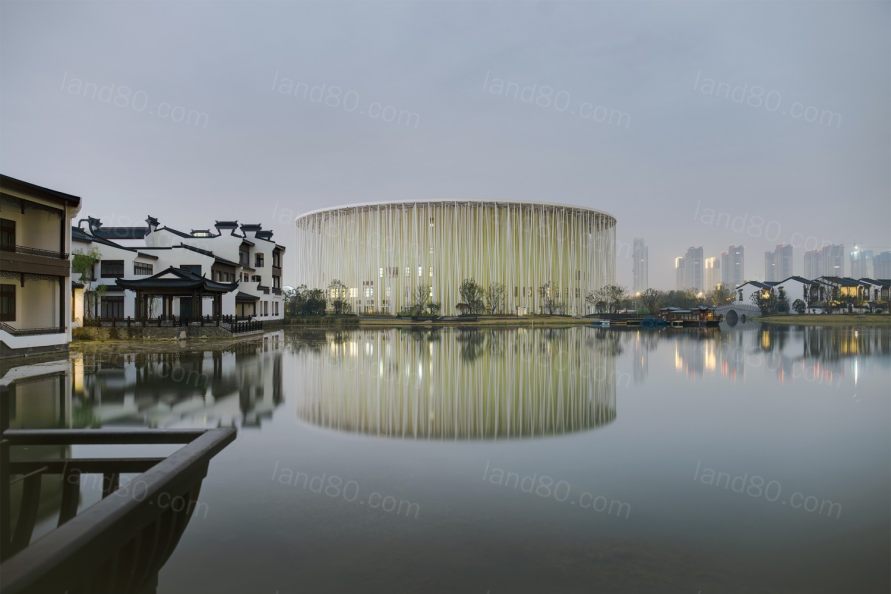无锡太湖剧院位于中国江苏省无锡市太湖之滨,其设计灵感来自于中国最大的竹林公园——宜兴竹海公园。拥有2000个座位,剧院被设计的初衷是供Franco Dragone的一场水上表演使用,剧院将于2019年12月22日开放。
Located close to Lake Taihu in Wuxi, Jiangsu Province, China, the Wuxi Taihu Show Theatre concept was inspired by the Sea of Bamboo Park in Yixing, the largest bamboo forest in China. The 2000 seat theatre has been designed to house a permanent water show by Franco Dragone and it is due to open on 22nd December 2019.

Photo©:Kris Provoost
建筑的外观由三个主要元素组成,柱子、遮阳篷和建筑围护结构。细长的白色圆柱代表了竹林的抽象印象,围绕着建筑的周边,在建筑立面和周围景观之间提供了一个屏障。“竹”柱清晰地围绕在各个入口周围,形成了建筑的入口框架。
The building’s appearance is composed of three primary elements, the columns, the shade canopy and the building envelope. Representing an abstract impression of a bamboo forest, the slender white columns are positioned around the perimeter of the building in such a way as to provide a screen between the building façade and surrounding landscape. The ‘bamboo’ columns clear around the various entrances to help frame the accesses into the building.

Photo©:Kris Provoost

Photo©:Kris Provoost

Photo©:Kris Provoost
遮荫的顶棚环绕着建筑的屋顶,从概念上讲,它代表了竹林顶部的冠层。顶棚由不同的三角形隔板组成,内含一排排金色阳极铝百叶窗。每个隔板的方向都是随机的,以创造一种有机的排布,在全天的任何时刻,斑驳的光影会落在建筑围护结构上。每个百叶窗的间隔的角度也不同,以增强从不同角度观看的变化感。
The shade canopy wraps around the perimeter of the building at roof level. Conceptually, it represents the canopy of leaves that exist at the top of a bamboo forest. The canopy is made up of various triangular bays containing rows of gold anodised aluminium louvres. Each bay is orientated randomly to create an organic quality to the structure and light and shade patterns that fall across the building envelope through the day. Each bay of louvres is also set at different angles to heighten the sense of variation when viewed from different angles.

Photo©:Kris Provoost

Photo©:Kris Provoost

Photo©:Kris Provoost

Photo©:Kris Provoost

Photo©:Kris Provoost
在结构上,每个天窗都由三角形的网格结构支撑,支撑着柱子的顶部,并将它们的负载转移到建筑的主要结构中。遮阳篷和柱子是为了整个建筑提供阴凉,能自然地降低建筑的冷却负荷。建筑围护结构主要由木块和幕墙玻璃组成,在入口处,玻璃幕墙的高度与建筑的高度一致,旨在为行人进入或离开建筑时提供最大的视野,由白色和金色的边框组成,贯穿整个建筑高度,模仿“竹”柱,使建筑成为竹林的“外边缘”。
Structurally, each bay of louvres is supported on a triangular lattice structure that braces the tops of the columns and transfers their load into the primary structure of the building. The environmental purpose of the shade canopy and columns is to provide shade over the surface of the façade and passively lower the cooling load on the building. The building envelope is primarily composed of rendered and painted block-work and curtain wall glazing. The glazing is the full height of the building in and above the entrance lobby to provide maximum views into and out of the main public areas. It is fritted with white and gold stripes that travel the full height of the building mimicking the ‘bamboo’ columns and contributing to the effect of the building being the outer edge of a forest of bamboo.

Photo©:Kris Provoost

Photo©:Kris Provoost
晚上,建筑的立面被从下面照亮,成为一个空灵的灯塔,在“竹”柱的森林中隐约可见,吸引着来自湖对岸和当地的居民与游客。
At night, the building envelop is illuminated from below, becoming an ethereal beacon, glimpsed between the forest of ‘bamboo’ columns, drawing spectators and audience in from across the lake and surrounding development.

Photo©:Kris Provoost

Photo©:Kris Provoost

Photo©:Kris Provoost
设计单位:SCA | Steven Chilton Architects
合作设计院:同济大学建筑设计
客户:融创中国
建筑与设计管理:融创中国
概念工程师:Buro Happold Engineering
剧院顾问:Auerbach Pollock Friedlander
表演设计:Dragone
Architect: SCA | Steven Chilton Architects
Client: Sunac Group
Architecture and Design Management: Sunac Group
Concept Engineer: Buro Happold Engineering
Theatre Consultant: Auerbach Pollock Friedlander
Show Design: Dragone
LDI: Tongji Architectural Design
|